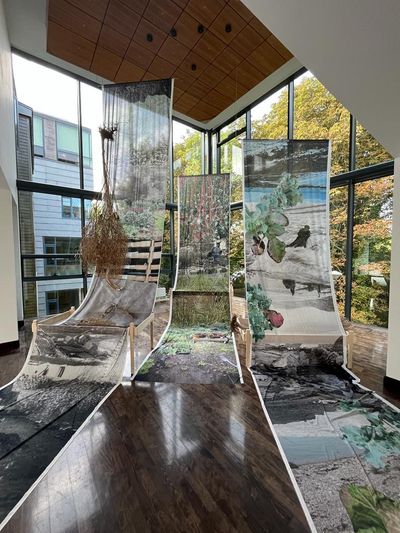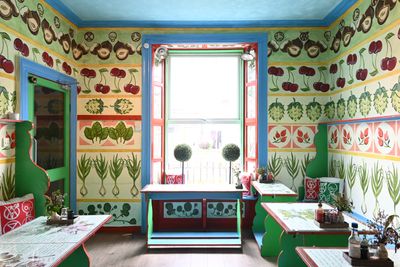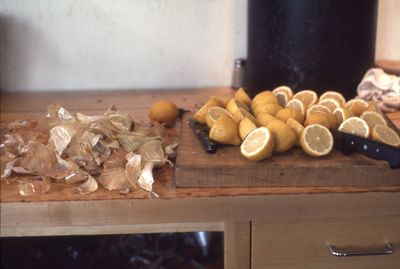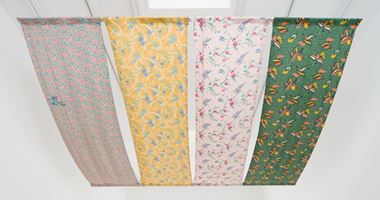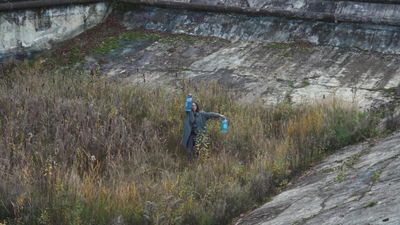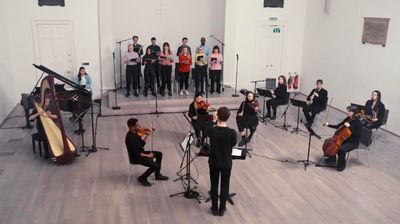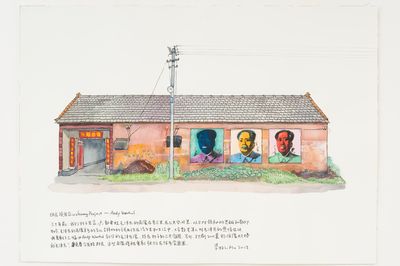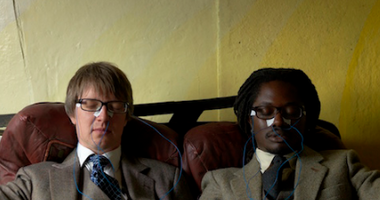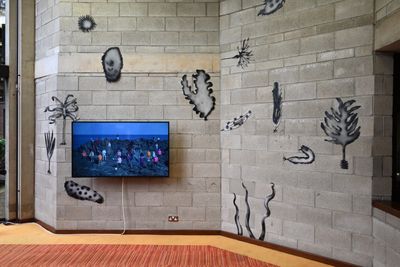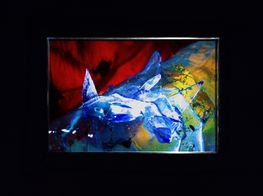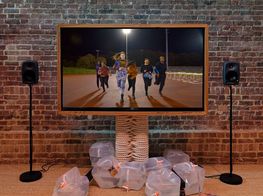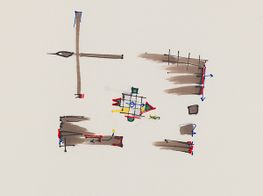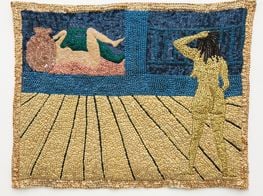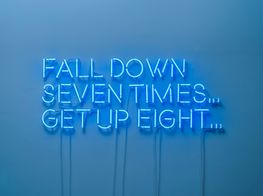EVA International Lets a Hundred Flowers Bloom

Rory Pilgrim, The Undercurrent (2019) (still). HD film. 50 min. Courtesy the artist.
Curated by Sebastian Cichocki, chief curator of Warsaw's Museum of Modern Art, the 40th edition of EVA International in the Irish city of Limerick, builds on the legacy of one of the world's oldest biennials.
Inaugurated in 1977, EVA is an impressive vehicle for ambitious exhibition-making that has made good use of Limerick's architectures to anchor this consciously international project to its context. The institution's ongoing Never Look Back project celebrates this fact with an online archive of the 160 and more locations that have participated in EVA through the years.
Conscious of that history, The Gleaners Society (31 August–29 October 2023), which refers to gathering leftover crops after the harvest, is a conscious return to EVA's roots. Veering from the monumental and more traditional exhibition spaces that have featured in recent editions, like Cleeve's Condensed Milk Factory, Cichocki curated over 45 works by Irish and international artists and collectives across 17 sites in the city.
Among the venues is The Commercial pub, whose walls are covered with images, posters, and documents surrounding Ireland's revolutionary struggle for independence and the civil war that followed.
Installed in an intimate snug, a historic trait of Irish pub architecture, is John Carson's art historical pub crawl, A Bottle of Stout in Every Pub in Buncrana (1978–1979). A framed poster tiles 22 photos of every pub Carson visited over one day in Buncrana, County Donegal, which are bookended by one shot of Carson drinking the day's first stout and one of Carson passed out after its last.
On a banquette's side table is a beer-stained binder containing correspondence between Carson—an Ulster Polytechnic graduate student at the time—and Irish dry stout producer Guinness, from whom Carson sought funding to print and distribute the poster.
Guinness rejected Carson's invitation, positioning itself in its letters as an arbiter of moderation unwilling to perpetuate the stereotype of the drunk Irishman. Then, when Carson politely informed the company of his intention to replace its name with 'stout' in the work's title, they objected, as if they owned the word.
It's hard to imagine a more perfect setting for Carson's intervention, unless you were in a pub in Buncrana itself. So perfect it was hard not to order a stout to reflect on the work with whomever was at the bar. (There was a biennial to review, after all.) Limerick, it has been said, is a friendly city, and Cichocki honours that character with venues that draw people in.
Take the family-run kitchen The Grove, whose walls and tables have been painted by Navine G. Dossos to document the histories and uses of plants in Ireland, from dandelion and fat hen to wild garlic. A rare veggie eatery in Limerick, The Grove is so popular that every table was occupied during my lunchtime visit by people for whom it would likely make no difference if there was an exhibition there or not.
In the end, I experienced Dossos' work while queuing for food that I ate on a shared, unpainted table outside; an immersive experience that upended the dynamic that often defines interventions like this, where a site is 'activated' into a static object for visitors to gawp at rather than experience wholeheartedly.
The Gleaners Society is anything but static or half-hearted. There's the section of the show scattered around the University of Limerick, abuzz with the energy of orientation week.
At the Millstream Building, documentation from FOOD, an artist-run restaurant founded in New York in 1971 by Gordon Matta-Clark, Carol Goodden, and Tina Girouard, shares space with hanging fabrics printed with images tracking the cultivation of wild kale in Ireland, by Asa Sonjasdotter, Merce Torres Ràfols, and NCAD FIELD. Both works create a loose but meaningful throughline to My-Musical (We-Musical) (2022), a video-musical screened in the Bourn Vincent Gallery nearby, produced by members of the My-Musical Collective, Pidsoma Shelter, and Lviv Kitchen.
My-Musical was filmed in a printing house in Lviv, Ukraine, which was converted into a performance centre by the cultural organisation soma.majsternia in 2019, before the Russian invasion turned the site into a refugee shelter, crisis eatery, and artist residency. Presented like a magazine show, a host in a chromakey studio introduces each segment, including cooks singing a borscht-making song, and people softly practising hand-to-hand combat, turning slaps into tender strokes.
That expression of communal softness amid calamity defines The Gleaners Society: a feeling that is palpable at the artist-founded, civic-minded Ormston House, which Cichocki describes as a portal into the entire show.
Reverberating through the gallery are the baroque, dream-pop sounds of Rory Pilgrim's concert broadcast, RAFTS (2020–2022). Commissioned amid the pandemic for the Serpentine Galleries exhibition Radio Ballads, Pilgrim worked with members of the non-profit Green Shoes Arts residing in Barking and Dagenham in London to reflect on what a raft symbolises for them.
...Cichocki opens heartfelt horizons that lean in to the emotional experience of living on a planet that finds itself in pieces because of human politics.
These reflections are threaded into a seven-song oratorio written by Pilgrim with vocalists Declan Rowe John, Robyn Haddon, and Kayden Fearon, and performed with the London Contemporary Orchestra, where nature emerges as a connecting thread. There's a poem by Mark Jones about a tree they depict with wire and moss in a small jar displayed next to the film; and an introduction to a 'secret garden' by Emily Butterfly Khoury.
Khoury's voice concludes the broadcast with an adaptation of Ecclesiastes 3. 'In everything that we do, we must make beauty for our time,' Khoury narrates over images of a sunset landscape. The amendment of the original masculine second person to a non-binary first-person plural, encapsulates the all-embracing sincerity defining both Pilgrim's project and The Gleaners Society as a whole. That spirit is heightened by a giant plan on one wall created by the Thomond Primary School Gardening Club and Deirdre O'Mahony, for a micro-forest that has been planted at the school as part of EVA.
Beautiful invitations for growth continue at the Limerick City Gallery of Art, where Pilgrim's The Undercurrent (2019), the precursor to RAFTS, is screened. Similarly composed of moving songs, forthright testimonies, and choreographed movements through spaces and landscapes, the film introduces ten inspiring youth climate activists from Boise, Idaho, who connect the necessity to form loving, accepting communities with the cross-generational need to protect an earth unable to sustain the divisive, extractivist culture that dominates it.
The unfiltered vulnerability in Pilgrim's films strikes at the heart of The Gleaners Society as a political exhibition unlike those that have come before it within EVA's rousing trajectory. Like when Koyo Kouoh proposed an urgent re-framing of the black-white dichotomy in decolonial discourse in 2016 by positioning Ireland as the first British colony. Or when Inti Guerrero necessarily dedicated a section of his 2018 show to the Repeal the Eighth Amendment campaign challenging Ireland's strict abortion ban.
Rather than build a political platform, Cichocki opens heartfelt horizons that lean into the emotional experience of living on a planet that finds itself in pieces because of human politics. Only when the heart is open, The Gleaners Society suggests, can uncharted ways to grow out of an unbearably static—and statist—present emerge.
Li Mu's Qiuzhuang Project (2013) is one attempt to push through the inertia. A video diary tracks the creation of a community library and reproduction of ten artworks from Western art history in the artist's village in China amid its government-planned demolition. Among the works are Warhol's Mao portraits and a nightly screening of Marina Abramović and Ulay's iconic 1970s performances in the village grocery store.
Each intervention opened up candid conversations within this close-knit community, which viewers are invited to witness, including nostalgia among elders who supported Mao's cause as youngsters and continue to revere him. Because while The Gleaners Society foregrounds sincerity in its reflections on community, it does not discount the complicated, fractal nature of communalism as a historic, lived, and idealised experience.
Diane Severin Nguyen's If Revolution is a Sickness (2021), screened in a house on Nicholas Street, distils these complexities into a thickly ambivalent view of collectivity as a commodifiable, popular youth culture. Filmed in Warsaw to engage with the Cold War history that connects with Poland's Vietnamese disaporas, the film follows a Vietnamese-Polish girl who grows up to join a Gen Z, K-pop inspired dance group.
Dressed in a dominant palette of—revolutionary, anarchist, fascist—black and red, with flashes of communist yellow, the group perform synchronised dances in front of politically significant sites. There's the Palace of Culture and Science, a 'gift' from Stalin after the Nazis obliterated Warsaw during World War II, fuelled by strategic Soviet inaction; and the so-called building of spies, in front of which Nguyen films red and yellow balloons spelling out 1989, the year the structure was mostly abandoned amid the fall of communism.
A script boils down words by political thinkers such as Hannah Arendt, Édouard Glissant, Ulrike Meinhof, and Mao Zedong, resulting in a music video in the final act whose lyrics transform the populist messaging of political propaganda into a catchy, emotive pop tune. ('You need words, we need bodies,' reads one line; 'Forget history,' reads another.)
'The result', writes scholar Rosa Boshier González, 'is a film that feels political without telling you how or why'. That observation circles back to The Gleaners Society and Cichocki's reference to the Latin root of propaganda: propagare, meaning to propagate or cultivate, in relation to gleaning.
As the group's dancing becomes more polished, their mimetic yet affective actions mirror the emotional formalism of the nationalist architectures behind them, echoing one lyric describing old flesh finding a new body—a cycle that relates to the work's title and its reference to Simone Weil's critique of Georges Bataille, who saw revolutionary struggle as an ecstatic, catastrophic sacrifice.
If Revolution is a Sickness seems to ask how to reroute that sacrifice, so that collective hope is not destroyed by decrepit politics once again—especially now that climate crisis demands a whole earth collaboration. Hence, Cichocki's final line in his text on the work, which redeploys a notorious 20th-century communist slogan for a present that demands redefinitions of growth: 'Let a hundred flowers bloom!' —[O]

